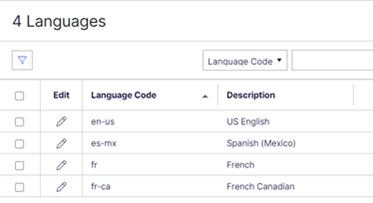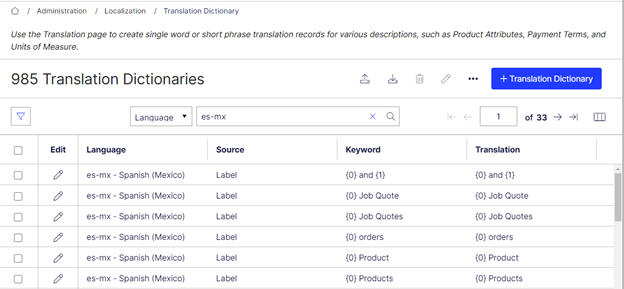XCentium GLT (Google Language Translate)
Seamlessly translate any foreign languages using XCentium GLT (powered by Google Translation API).
Description
Adding the new Language to a Configured Commerce solution is easy but then you are left with the task of populating each of the translations. Populating the translations is a challenge that every Optimizely website faces when dealing with foreign language support.
This service uses your configured default language as a base for translations and populates translations for your other configured languages using the Google Translation API. The foreign languages that can be translated by the service must first be added to the Enabled Languages for the target website:
 Translation Dictionary and Field Translations
Translation Dictionary and Field Translations
The Translation Dictionary is a system built into the Optimizely Configured Commerce Cloud platform that allows a developer to define a string as translatable. Then, using the Translation Dictionary in the Admin Console, an admin can define the foreign language translation for each translatable string. This typically applies to content on the site, not product data. When the site is rendered using a supported foreign language, all translatable strings will appear in that language, assuming a translation was made.
Additionally, Configured Commerce has field translations. This is where more focused elements of the site are translated into other languages, such as Categories, Brands, Attributes, and various other data items.
This is where this Service takes over. The service will look at your translatable strings and translate them into the target foreign language for you with a few button-clicks.
 There are two modes that the Google Translate API can operate: basic and advanced. In basic mode, strings must be translated one at a time by the Google Translate API. This makes this option slower, but it is free, so the price is right for smaller and smaller-medium sized Translation Dictionaries. In advanced mode, an array of strings can be passed at once to the Google Translate API. This makes the service faster but has an additional cost.
There are two modes that the Google Translate API can operate: basic and advanced. In basic mode, strings must be translated one at a time by the Google Translate API. This makes this option slower, but it is free, so the price is right for smaller and smaller-medium sized Translation Dictionaries. In advanced mode, an array of strings can be passed at once to the Google Translate API. This makes the service faster but has an additional cost.
For this service, the basic api is used for translations. The service is accessed using an Integration Job. The Integration Job can be triggered as frequently as you need based on your use case. In simple situations, running it once would be sufficient. The Integration Job will generate sufficient logs to notify you of the progress as the translations are generated.
Once the Integration Job Is complete, you can view the generated Translations in the Translation Dictionary and Field Translations using the Optimizely Configured Commerce Cloud Admin Console.
There is one optional parameter that can be used during the job-
Target Language ISO-639 Code allows you to select a specific language and run only those translations. This is useful for updating translations for one language without changing your other language translations.
Once the translations are complete, they can be viewed/updated in the Translation Dictionary and Field Translations views in the Admin console. This allows you to modify any translation that you want to manually override. As you can see below, the Google Translate API is smart enough to handle common symbols, placeholders and abbreviations.